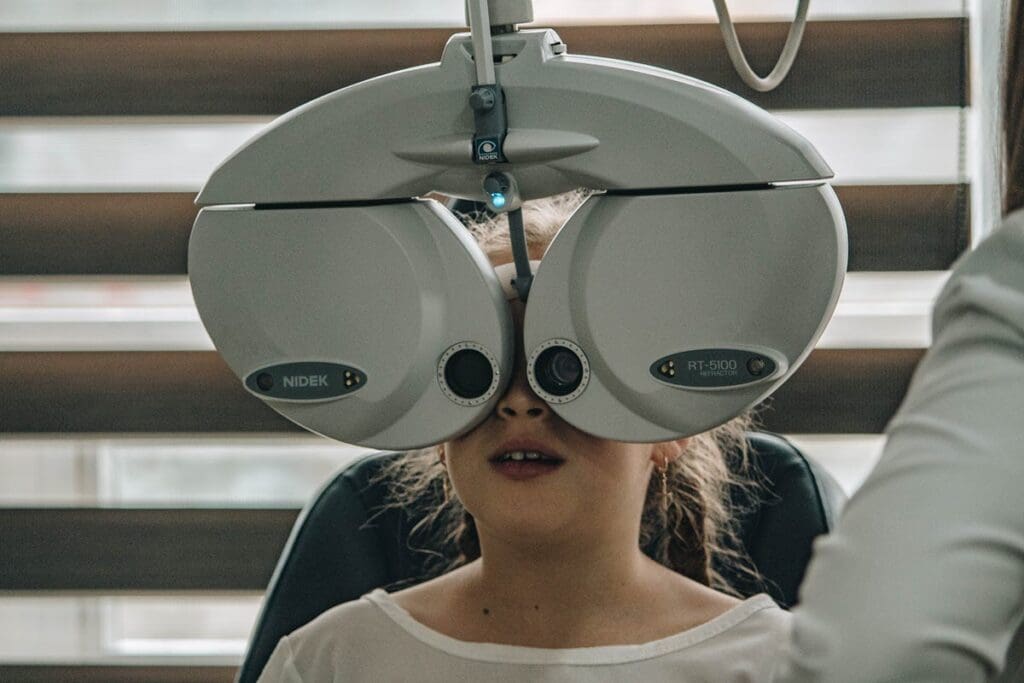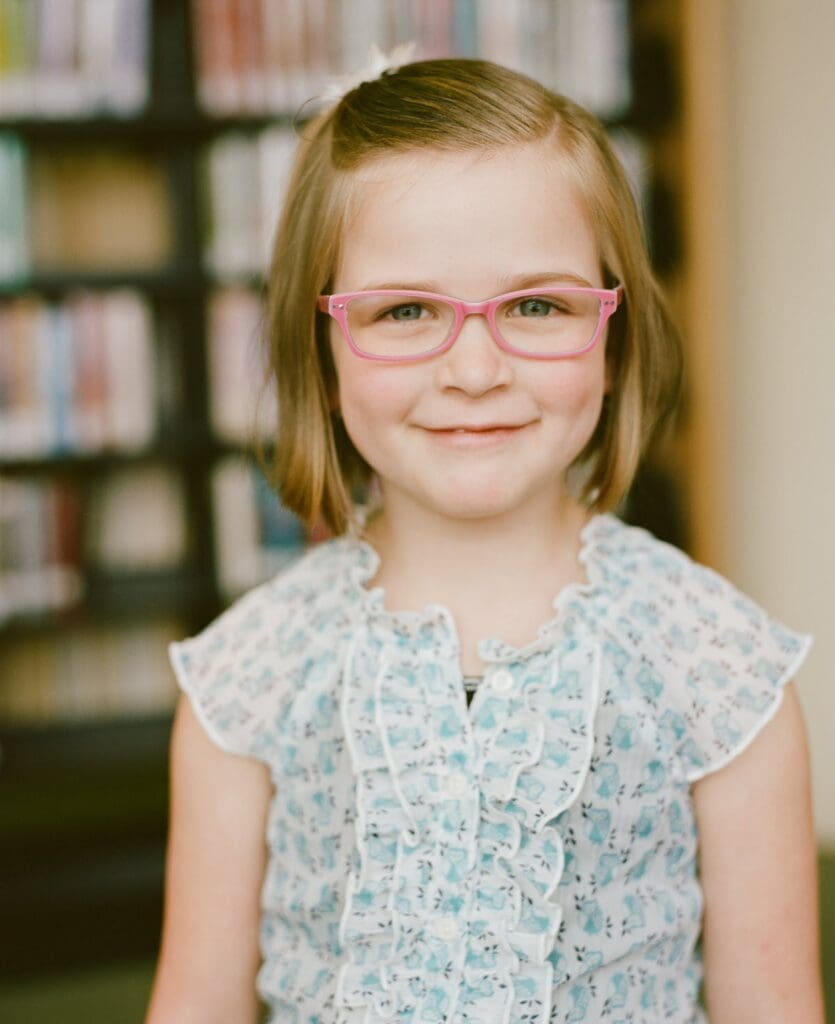
Reviewed by
Dr. Carli Bunn - Optometrist at Eye Care Associates
Children’s eyes and vision develop gradually and should be screened over the course of their lives. As your child ages, you may notice warning signs of common conditions for their age group. These conditions must be diagnosed and treated to allow your child’s vision to develop normally.

There are also many things you can do to help your child develop better eyesight or preserve their eye health. Taking your child for regular eye exams and getting them to wear their glasses or contact lenses as prescribed are two of the most important.
Children’s Eye Health at Every Age
Newborns (0 to 2 Months)
Newborns are still developing full vision when they are born. They cannot see at a distance and mainly focus their vision on objects that are very close to them. After 6 weeks of age, they should be able to follow an interesting object (such as a caregiver’s face or a colorful toy) with their eyes for brief periods of time.
Many newborns develop chronic discharge from their eyes. This discharge is usually yellowish and sticky. It may build up so much overnight that your newborn wakes up unable to open their eyes. If this happens, you can gently clean away the build-up with a clean, soft cloth and some lukewarm water.
Newborns are very vulnerable to eye infections (also known as conjunctivitis or pinkeye). Many hospitals apply a coat of erythromycin ointment to newborns’ eyes to combat this problem. Look out for signs of conjunctivitis in your newborn (such as redness or inflammation in the eyes) and seek treatment if you spot them.
Babies (2 to 24 Months)
Once they are a few months old, babies should be able to:
When your baby is around 6 months old, they should have their first eye screening.
- Maintain eye contact with caregivers during interactions.
- Track a moving object, like a ball in a sports game.
When babies are older than 4 months, their eyes should not frequently look crossed or misaligned. If they do, your child should be examined for amblyopia (lazy eye) or strabismus (walleye).
When your baby is around 6 months old, they should have their first eye screening. During this exam, their eye doctor will test their eyesight and eye muscle coordination. This is a limited assessment that will not catch all eye problems, but it is helpful for catching severe vision issues at an early age.
Toddlers (2 to 5 Years)
When children reach the toddler stage, they begin to develop better vision, particularly in terms of hand-eye coordination. They should be able to do things like draw or color and use building blocks, both of which develop the visual skills they will need when learning to read and write.
At this age, conditions like strabismus and amblyopia often become apparent. Toddlers with misaligned or drifting eyes should see an optometrist for diagnosis. These conditions may be treated with eye exercises, glasses, or an eye patch depending on your child’s needs.
This is also the age at which some children first begin to show signs of refractive errors, such as myopia or astigmatism. While many refractive errors will only develop a little later in a child’s life, any that are apparent at this age should be diagnosed and treated as soon as possible.
School Age (6 to 12 Years)
When your child reaches school age, they begin to face much higher visual demands in their daily life. They are expected to perform many visual tasks during each school day. At this stage, they should be able to:
- See things clearly both up close and in the distance, and switch between them without losing focus.
- Recognize images on a page as letters and words, and understand and remember the ideas they read.
- Use both eyes together to judge distance, depth, and speed.
- Maintain good hand-eye coordination during common tasks like writing or catching a ball.
If they cannot do these things, they may have a vision issue that requires treatment. Refractive errors like myopia (nearsightedness), hyperopia (farsightedness), and astigmatism are commonly identified in this age range and can cause problems with all these tasks. These conditions are easily treated using glasses or contact lenses.
Sometimes a child’s struggles with vision impairment are less obvious. Some common symptoms of eye problems in this age group include:
- Frequent blinking and eye rubbing.
- Frequent headaches, eye pain, and other eye-related discomfort.
- Double vision.
- Tilting their head to one side.
- Holding reading materials very close to their face.
Conjunctivitis is also extremely common in school-aged children. This is because it is usually caused by viruses or bacteria which can be easily spread from child to child. If your child develops red, itchy eyes, take them to their doctor for an exam. They may be prescribed antibiotics to help the infection clear up.
Teenagers (13 to 17 Years)
By the time children reach their teenage years, most early eye problems will have been detected and treated.
Eye infections are also common among teens.
Occasionally, a teen will be diagnosed with refractive errors that were missed during their earlier years or developed later in life. These conditions can be treated with eyeglasses or contacts.
Many teens suffer from a scratched cornea at some point during these years. This usually happens when the eye comes into contact with foreign objects, such as dirt, sand, wood chips, or even contact lenses. These injuries are painful, but most heal in a few days without treatment. However, it is best to have an eye doctor examine the injury anyway to be certain that there are no foreign particles still stuck in the eye.
Eye infections are also common among teens. This happens due to common mistakes like sharing eye makeup or not cleaning contact lenses properly before wearing them. If your child develops red or itchy eyes, have them see their doctor for a diagnosis and a prescription for antibiotics.
Young Adults (18 years and up)
By the time a person reaches young adulthood, their vision has fully developed and almost all pre-existing eye health problems have been identified. Most of the eye health problems that occur in this age range are due to environmental factors.
- Eye strain is a common problem in this age group due to the heavy visual demands of post-secondary studies and white-collar work. If your child works with or studies using computers, remind them to take frequent breaks and employ the 20-20-20 rule whenever possible.
- Many young adults spend significant amounts of time outdoors without protection from the sun’s UV radiation. With enough exposure, this radiation can damage their eyes. To prevent this, ask your child to wear sunglasses with UV protection while outdoors.
- Eye injuries are also common among young adults. Have your child continue to wear protective eyewear when doing anything that poses a risk of eye injuries, such as contact sports or mowing the lawn.
How to Help my Child Develop Good Eyesight
To help your child’s vision development:
- Hang a colorful mobile over your child’s crib. This gives them something interesting to look at while lying down and trains their eyes to focus better on distant objects.
- Allow your child plenty of time to explore their environment. The more they see and do, the more opportunities they will have to develop different aspects of their eyesight.
- Give your child lots of toys and activities that are stimulating to the eyes. Some examples include puzzles, art supplies, jewelry making supplies, and wooden or plastic blocks.
- Spend time with your child outdoors on a regular basis. While researchers are not sure why this happens, children who are exposed to outdoor environments more often are less likely to develop myopia (nearsightedness).
How Often Do They Need Eye Exams? (By Age)

Family doctors or pediatricians can screen children without diagnosed eye issues for vision problems. This should be done:
- First at around 6 months of age
- Then once a year from ages age 3 to 5
- And then once every one to two years afterwards until age 16
Children may need more frequent and more comprehensive eye exams if they have:
- A diagnosed refractive error, eye disease or another optical condition
- Signs of nearsightedness, misaligned eyes or lazy eye
- A family history of genetic eye disease
- Red, swollen or cloudy eyes
Glasses and Contact Lenses for Children
Children might wear glasses to:
- Correct vision impairments like refractive errors (myopia, hyperopia, or astigmatism)
- Strengthen eyes with misalignment issues (such as strabismus or amblyopia)
If an optometrist prescribed glasses for your child, they should wear them as prescribed. If they do not, their vision may not develop correctly.
Older children or teens can wear contact lenses. Do not offer contact lenses to your child unless you are certain that they will wear them as prescribed and follow proper hygiene practices to avoid infection.
Children may resist wearing their glasses at first. To help them adjust:
- Choose frames that fit your child’s face now. This will make them more comfortable to wear. By the time your child grows into oversized frames, their vision may have changed.
- Look for frames with soft, flexible materials on the ends. This will make the glasses fit more comfortably around your child’s ears.
- Add an elastic strap or ear grips to your child’s frames to help them keep their glasses in place.
If your child is still not wearing their glasses consistently after 2 weeks or is complaining that they cannot see properly through their glasses, consult your eye doctor. Your child may have an underlying eye issue that has not been identified yet.
How to Protect Children’s Eyes
Eye injuries are a common problem among children of all ages. To prevent them, your child should:

- Wear safety or sport glasses with shatterproof lenses when participating in sports with a high likelihood of eye injuries, including baseball, basketball, field hockey, and more. If your child plays hockey or lacrosse, they should wear a full helmet with a face mask.
- Wear eye protection when doing or observing chores like mowing the lawn, using power tools, or cleaning with hazardous chemicals. If you are with your child while you are doing these things, be sure to wear eye protection yourself as well.
- Wear eye protection that meets military ballistic standards when using firearms at a shooting range or participating in paintball games.
- Wear sunglasses with UV protection when spending significant amounts of time outdoors.
Tips to Keep Your Children’s Eyes Healthy
You can help keep your child’s eyes healthy for life by:
- Feeding your child a balanced diet. Ensure that they get plenty of vitamin A, C, and E, as well as omega-3 fatty acids, zinc, and lutein. Some good sources of these nutrients include leafy greens, fish, eggs, oranges, and berries.
- Limiting your child’s screen time. Too much time spent looking at screens can increase your child’s risk of developing eye strain or myopia. If they must spend a long time in front of a screen (for example, during distance learning), have them practice the 20-20-20 rule: look up from the screen every 20 minutes at something that is at least 20 feet away, and hold that gaze for at least 20 seconds.
- Choosing polycarbonate lenses (if your child wears glasses). These lenses are shatterproof and will not crack or break during active play, keeping your child’s eyes safe from glass shards.
- Watching out for warning signs of vision problems. Symptoms such as squinting, eye rubbing, and sensitivity to lights can indicate a developing vision issue. If you notice any of these behaviors, make a screening appointment with your child’s doctor.
References
-
School-Aged Vision: 6 to 18 Years of Age. (2021). American Optometric Association.
-
Preschool Vision: 2 to 5 Years of Age. (2021). American Optometric Association.
-
Infant Vision: Birth to 24 Months of Age. (2021). American Optometric Association.
-
Adult Vision: 19 to 40 Years of Age. (2021). American Optometric Association.
-
Taking Care of Your Vision. (June 2014). Nemours KidsHealth.
-
Eye and Vision Tests for Children and Teens. (August 2020). University of Michigan Health.
-
20 Things to Know About Children’s Eyes and Vision. (December 2019). American Academy of Ophthalmology.
-
Warning Signs of Vision Problems in Infants & Children. (July 2016). American Academy of Pediatrics.
-
Conjunctivitis (Pink Eye) in Newborns. (January 2019). Centers for Disease Control (CDC).
-
Glasses for Children. (March 2020). American Association for Pediatric Ophthalmology & Strabismus.
-
6 Ways to Be Proactive About Your Child’s Eye Health. (2021). Johns Hopkins Medicine.
-
Children’s eye health. (September 2019). College of Optometrists.
-
Preventing Eye Injuries. (September 2021). Nemours KidsHealth.
Last Updated February 22, 2022
Note: This page should not serve as a substitute for professional medical advice from a doctor or specialist. Please review our about page for more information.